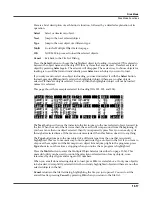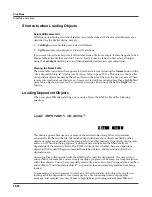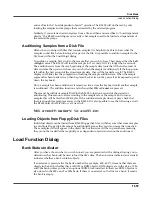
13-4
Disk Mode
SCSI Termination
If you have an internally terminated computer, a K2600 and an external hard disk with
two
SCSI
ports, setting up is also painless. Connect the computerÕs SCSI port to one of the hard diskÕs
SCSI ports, and the K2600Õs SCSI port to the hard diskÕs other SCSI port. Make sure the hard
disk is not terminated, since itÕs in the middle of the chain. In this conÞguration (with a
terminated computer at one end and the K2600 at the other), you can chain up to six hard disks
between them. Make sure theyÕre all unterminated, and donÕt forget to set each diskÕs SCSI ID to
a different value.
Disabling the K2600’s SCSI Termination
If you have a computer, a K2600 and an external hard disk with only
one
SCSI port, thereÕs only
one way to set them up: put the K2600 in the middle (with one SCSI port connected to the
computer, and the other to the hard disk). In this case, you can either change the setting of the
SCSI Termination switch to Disable (which means that termination is always off), or you can
leave it set to Auto, which means that if you put the K2600 in a conÞguration that requires it to
be terminated, it will enable its internal termination automatically (and disable it when
appropriate, as well).
If you install an internal hard disk in your K2600, we recommend that you leave the K2600Õs
SCSI Termination switch set to Auto. If your K2600 is going to be at the end of a SCSI chain
(which is what we recommend), then the internal hard disk must be terminated. If the K2600 is
going to be in the middle of a chain, the internal hard disk must be unterminated (we donÕt
recommend this).
If youÕre planning to buy an external SCSI hard disk to use with your K2600, itÕs a good idea to
buy one with two SCSI ports. Most new hard disks have two ports, and can be terminated or
unterminated relatively easily. This gives you added ßexibility, since you can install it at the end
of a chain, leaving its termination in place, or in the middle of a chain, using both its SCSI ports,
and removing its termination.
When your SCSI device is connected, you can select it with the Current disk parameter on the
Disk-mode page. Use any data-entry method to select the SCSI ID that matches the SCSI ID of
your SCSI device. If youÕre using the alphanumeric buttonpad to select the device, enter
9
to
select the ßoppy. Newer SCSI devices usually have an external switch for setting their IDs. Older
units may not have these; check your deviceÕs ownerÕs manual for its SCSI ID.
Using your K2600 in a SCSI System
SCSI IDs
All devices in a chain of SCSI devices must have different SCSI IDs, including the K2600. The
K2600Õs SCSI ID is set at 6 by default, and can be changed on the RECEIVE page in MIDI mode.
If your SCSI system includes an Apple
¨
Macintosh,
¨
be sure not to use SCSI ID 7 for any of your
other devices, since the MacÕs SCSI ID is 7, and canÕt be changed.
Once youÕve made sure that all connected devices are set to different SCSI IDs, you should be
able to select the devices, format them, and start loading and saving Þles.
Formatting a SCSI Device
The procedure for formatting hard disks is essentially the same as with ßoppy disks, once the
SCSI device is selected with the CurrentDisk parameter. The K2600 will recognize the disk as a
SCSI disk, and will warn you that formatting will erase the contents of the disk. Compared with
personal computers, the K2600Õs formatting time for SCSI disks is surprisingly short.
Summary of Contents for K2600 BEST OF VAST - REV A
Page 76: ......




































